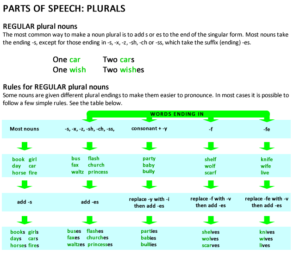The most common way to make a noun plural is to add s or es to the end of the singular form. Most nouns take the ending -s, except for those ending in -s, -z, -sh, -ch or -ss, which take the suffix (ending) -es. Some nouns are given different plural endings to make them easier to pronounce. In most cases it is possible to follow a few simple rules. LOOK:

Parts of Speech: How to spell Regular Plural Nouns
For most nouns we add an -s,
- book – books
- girl – girls
- car – cars
- day – days
- horse – horses
- fire – fires
Nouns ending in -s, -z, -sh, -ch or -ss, we add -es
- bus – buses
- flash – flashes
- church – churches
- fax – faxes
- waltz – waltzes
- princess – princesses
Nouns ending in a consonant +y, we remove the –y and add –ies
- baby – babies
- party – parties
- bully – bullies
Nouns ending in an -f, we remove the –f and add –ves
- scarf – scarves
- shelf – shelves
- wolf – wolves
Nouns ending in an -fe, we remove the –fe and add –ves
- knife – knives
- wife – wives
- life – lives
SUBSTANTIVOS PLURAIS REGULARES
A maneira mais comum de tornar um substantivo plural é adicionar o -s ou -es no final da forma singular. A maioria dos substantivos toma o -s no final, exceto para aqueles que terminam em -s,-z,-sh,-ch ou-ss, que levam -es no final.
- one dragon two dragons
- one wish two wishes
Regras para substantivos plurais REGULARES
Alguns substantivos recebem diferentes terminações no plural para torná-los mais fáceis de pronunciar. Na maioria dos casos, é possível seguir algumas regras simples. Consulte a tabela abaixo.

